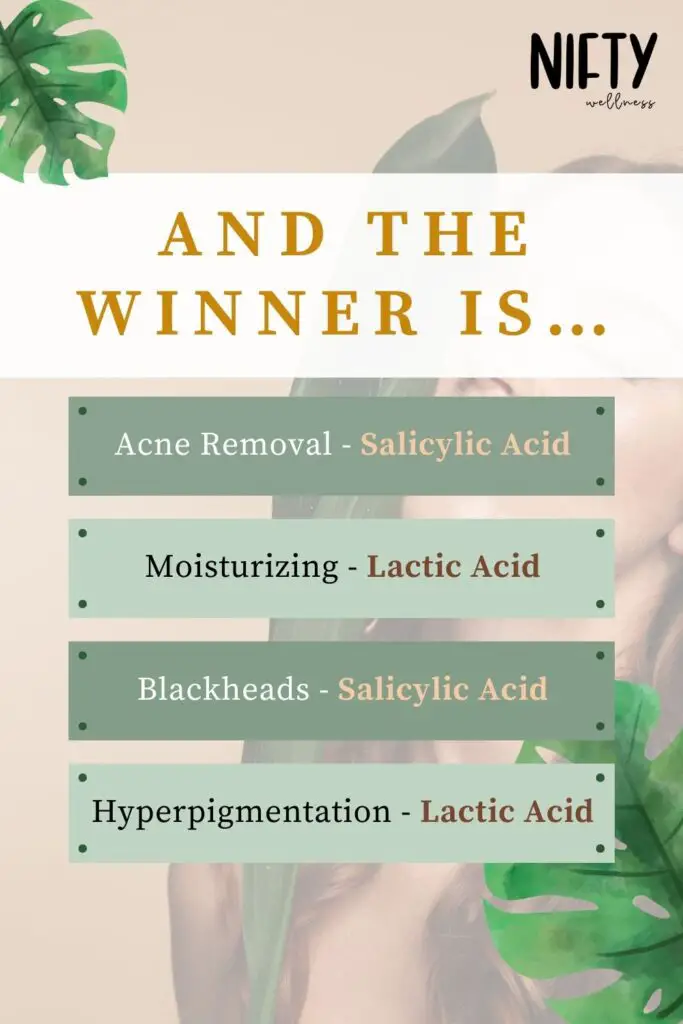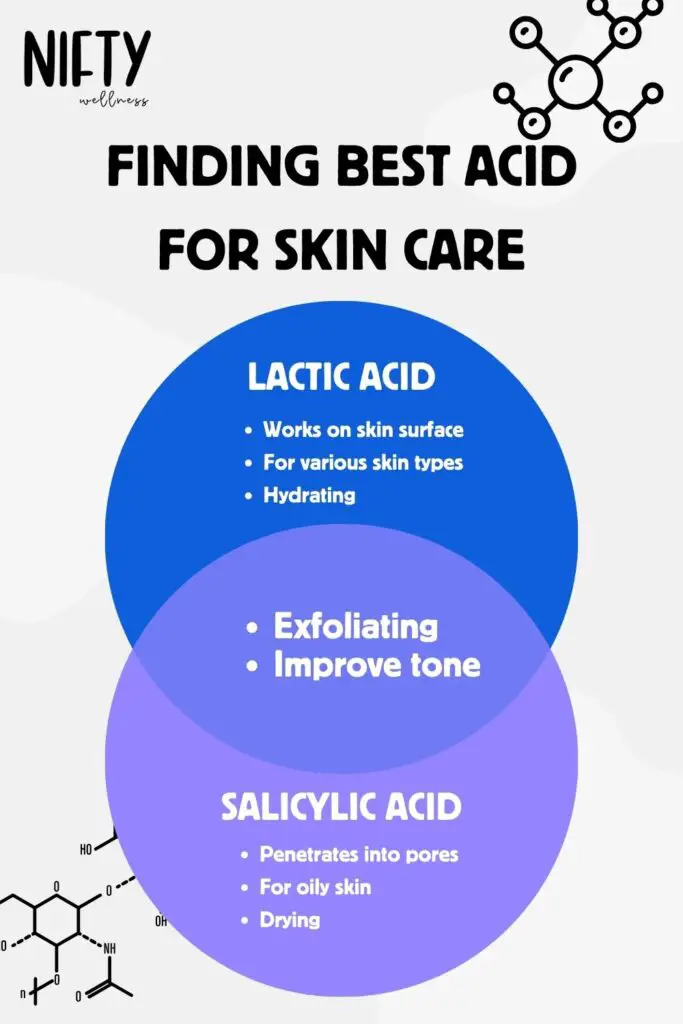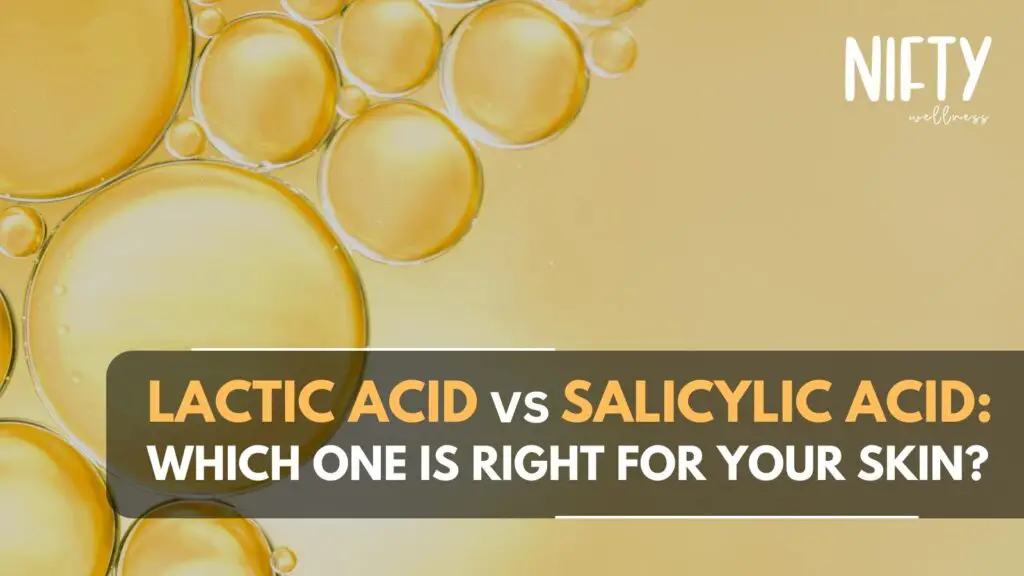Embarking on the journey to radiant skin often involves deciphering the world of skincare ingredients. Amidst the myriad options, lactic acid and salicylic acid stand out as transformative agents. Understanding their nuances and benefits is crucial for crafting an effective skincare routine that leads to a luminous complexion.
Navigating through the skincare landscape, it becomes evident that achieving radiance goes beyond mere surface-level efforts. Lactic acid vs salicylic acid, two potent chemical exfoliants, offer unique advantages tailored to different skin concerns. In this exploration, we will unravel the secrets of these acids, exploring their benefits, key differences, and unveiling the path to radiant skin.
What is Lactic Acid?
Before we delve into the benefits, similarities, and differences of these acids, let us first understand whats lactic acid. Lactic acid, derived from sour milk, belongs to the family of alpha-hydroxy acids (AHAs). Unlike some harsher exfoliants, lactic acid exhibits a gentle touch, making it suitable for various skin types, including sensitive skin. The magic lies in its ability to dissolve dead skin cells, promoting cell turnover and revealing a smoother, brighter complexion.
Lactic Acid Benefits

Here are some key AHA benefits:
- Gentle Exfoliation: Lactic acid delicately exfoliates the skin’s surface, shedding dead skin cells without causing irritation, making it ideal for sensitive skin.
- Hydration Boost: This AHA offers a unique trait by providing hydration, ensuring that the exfoliation process doesn’t compromise the skin’s moisture barrier.
- Hyperpigmentation Treatment: Lactic acid emerges as a champion in reducing hyperpigmentation, effectively addressing dark spots and uneven skin tone.
- Improved Skin Texture: Regular use of lactic acid contributes to enhanced skin texture, leaving it soft, supple, and noticeably smoother.
Lactic Acid for Acne
Lactic acid emerges as a valuable ally in acne management. Unlike traditional spot treatments, lactic acid doesn’t just dry out blemishes; it employs a dual mechanism of exfoliation and hydration. This unique approach accelerates cell turnover, prevents acne formation, and promotes the development of new, healthy skin.
Lactic Acid for Hyperpigmentation
When it comes to hyperpigmentation, lactic acid proves to be a game-changer. Its multifaceted action, combining exfoliation and hydration, not only aids in reducing hyperpigmentation but also contributes to a more even skin tone. As a humectant, lactic acid attracts moisture, fostering the renewal of skin cells and mitigating the appearance of hyperpigmented areas.
Lactic Acid for Dry Skin
For those with dry skin, lactic acid offers a solution by addressing the root causes of breakouts. As a humectant, lactic acid is known to attract moisture to the skin. This promotes hydration while preventing dehydration-related acne production. Additionally, lactic acid unclogs pores, gently exfoliating dead skin cells and eliminating excess oil, resulting in improved skin texture for individuals with dry skin.
Check out our latest blog Avene vs CeraVe: Which Skin Care Brand is Right for You? Discover the key differences and find out which brand suits your skin’s needs best.
What is Salicylic Acid?
Salicylic acid, on the other hand, is a beta-hydroxy acid (BHA) derived from willow bark. Renowned for its prowess in penetrating oily skin and unclogging pores, salicylic acid is a go-to for those grappling with acne and blackheads.
Salicylic Acid Benefits

Here are some key BHA benefits:
- Unclogs Pores: Salicylic acid’s exceptional ability to penetrate oil makes it highly effective in unclogging pores, a key factor in preventing acne.
- Blackhead Treatment: If battling blackheads is a concern, salicylic acid for blackheads offers a potent solution by breaking down the substances that contribute to these imperfections.
- Anti-Inflammatory Properties: Salicylic acid brings anti-inflammatory qualities to the table, soothing redness and calming irritated skin.
- Prevents Acne Breakouts: Regular use of salicylic acid helps prevent acne breakouts by keeping the pores clear of debris and excess oil.
Salicylic Acid for Pores
Salicylic acid is renowned for its exceptional ability to address pores. By penetrating deep into the skin, it effectively exfoliates within the pore lining, preventing congestion and minimizing the appearance of enlarged pores. Regular use of salicylic acid can contribute to a smoother complexion by keeping pores clear and reducing the risk of breakouts.
Salicylic Acid for Dark Spots
In the realm of dark spots, salicylic acid stands out as a potent solution. Its exfoliating properties help break down the substances that contribute to dark spots, promoting a more even skin tone. By encouraging the shedding of pigmented cells, salicylic acid contributes to a brighter and revitalized complexion.
Salicylic Acid for Dry Skin
While salicylic acid is not typically associated with dry skin, its targeted exfoliation can benefit those with dry skin concerns. Salicylic acid helps maintain optimal skin health by removing dead skin cells and creating a balanced skin environment. Whether you are using it for your face or if you are using salicylic acid for legs, It’s crucial, however, to complement its use with a nourishing moisturizer to counteract potential dryness.
Salicylic Acid for Scar Reduction
Does salicylic acid help with scars? Salicylic acid can aid in reducing the appearance of scars, particularly those caused by acne. Salicylic acid is a great exfoliant. It helps in removing dead skin cells, and at the same time. Esteemed by many, this treatment is commended for its capacity to illuminate and exfoliate the skin. It also promotes cell turnover. With the help of this property, salicylic acid is known for potentially fading scars over a period of time. Additionally, salicylic acid’s ability to unclog pores and reduce inflammation may improve overall skin texture, potentially minimizing the visibility of scars. However, results may vary, and it’s advisable to consult a dermatologist for personalized scar treatment recommendations.
Read our blog Obagi Blender vs Clear: Choosing the Right Skincare Product. See how these skincare products transform your complexion.
Must-have Lactic Acid and Salicylic Acid Products

Attaining luminous and blemish-free skin frequently requires integrating potent ingredients such as lactic acid and salicylic acid into your skincare routine. These chemical exfoliants offer unique benefits, from gentle resurfacing to deep pore cleansing. Now that you know the benefits of AHA and BHA, explore our curated list of must-have lactic acid and salicylic acid products to elevate your skincare regimen and unveil a brighter, smoother complexion. In addition to these products, you can also check out lactic acid shampoo, lactic acid mask, lactic acid cleanser & more for personalized skincare.
Best Lactic Acid Products
- The Ordinary Lactic Acid 5% + HA: This serum from The Ordinary combines lactic acid with hyaluronic acid for gentle exfoliation and enhanced hydration. It’s known for its effectiveness in improving skin texture and reducing hyperpigmentation.
- Sunday Riley Good Genes All-In-One Lactic Acid Treatment: Users commend this treatment for its capacity to illuminate and exfoliate the skin. It contains purified lactic acid and promises a more radiant complexion with continued use.
- Pixi Glow Tonic with 5% Glycolic Acid and Lactic Acid: Pixi’s Glow Tonic has gained popularity for its exfoliating properties, thanks to the inclusion of glycolic and lactic acids. It’s designed to reveal brighter and smoother skin, making it a beloved choice in many skincare routines.
- REN Clean Skincare Ready Steady Glow Daily AHA Tonic: This AHA tonic by REN Clean Skincare is formulated with lactic acid and azelaic acid. It aims to promote a smoother and more even skin tone while being gentle enough for daily use. People call it the best lactic acid for skin.
- Paula’s Choice Skin Perfecting 8% AHA Lotion: Paula’s Choice offers a potent 8% AHA lotion containing lactic acid. This product is celebrated for its exfoliating prowess, addressing various skin concerns like dullness and fine lines.
Best Salicylic Acid Products
- The Ordinary Salicylic Acid 2% Solution: Known for its affordability and effectiveness, The Ordinary Salicylic Acid Solution is a targeted treatment for blemishes and blackheads. It works to exfoliate inside the pores, keeping them clear.
- Neutrogena Oil-Free Acne Wash: Neutrogena’s Oil-Free Acne Wash is a classic choice for those dealing with acne. Formulated with 2% salicylic acid, it helps treat and prevent breakouts while effectively cleansing the skin.
- Paula’s Choice Clear Regular Strength 2% BHA Liquid Exfoliant: This liquid exfoliant from Paula’s Choice is a fan favorite. With 2% salicylic acid, it targets enlarged pores and promotes smoother, clearer skin without over-drying.
- COSRX Salicylic Acid Daily Gentle Cleanser: COSRX’s Salicylic Acid Cleanser is lauded for its gentle yet effective formula. It’s designed to remove impurities and excess oil, making it suitable for daily use, especially for those with oily or acne-prone skin.
- La Roche-Posay Effaclar Medicated Gel Acne Cleanser: Formulated with 2% salicylic acid, this gel cleanser from La Roche-Posay is designed for acne-prone skin. It helps to target breakouts and clear the skin while maintaining its pH balance.
Similarities between Lactic Acid & Salicylic Acid
Despite belonging to distinct acid families—lactic acid being an alpha-hydroxy acid (AHA) and salicylic acid a beta-hydroxy acid (BHA)—these skincare powerhouses share several commonalities. Both salicylic acid and lactic acid are revered for their exceptional exfoliating abilities, contributing to smoother skin texture, improved tone, and an overall renewal of the skin’s surface.
Key Differences between Lactic & Salicylic Acid

Navigating the realm of skincare involves understanding the distinctive qualities of key ingredients. In the case of lactic and salicylic acids, their differences play a crucial role in addressing various skin concerns. Let’s delve into the key difference between aha and bha to empower you in making informed choices for your skincare regimen.
Skin Penetration
Lactic Acid: Primarily operates on the skin’s surface, delivering gentle exfoliation.
Salicylic Acid: Penetrates deep into the pores, facilitating effective exfoliation within.
Suitability
Lactic Acid: Versatile, suitable for various skin types, including sensitive skin.
Salicylic Acid: Tailored for oily and acne-prone skin.
Moisturizing Properties
Lactic Acid: Exhibits hydrating properties, contributing to skin moisture.
Salicylic Acid: Can be drying, underscoring the importance of combining it with a nourishing moisturizer.
Targeted Concerns
Lactic Acid: Effectively addresses hyperpigmentation and works towards overall skin brightening.
Salicylic Acid: Particularly adept at combating acne blackheads and minimizing enlarged pores.
Public Opinion & Reviews

Starting a skincare journey with salicylic acid vs lactic acid can lead to remarkable transformations. ‘Is lactic acid bad for you?’ The users often applaud lactic acid’s gentle exfoliation, unveiling a more radiant and even-toned complexion. Sharing her lactic acid before and after the experience, Sonia Anastasia said,
” I feel like this is a definitely a good product for beginners if you are too scared of like the red serum or even retinoids I feel like lactic acid even glycolic acid that’s pretty intense lactic acid is like really good it’s like really gentle and forgiving so yeah I would definitely recommend that”.
On the other hand, salicylic acid enthusiasts praise its effectiveness in combating acne blackheads and promoting clearer skin texture.
While sharing The ordinary salicylic acid before and after the review, Lavinia Rusanda said,
“I know that salicylic acid is something that my skin likes, and I do think that this was kind of supporting that healing process and getting these breakouts to calm down and dry up a lot faster so the skin may appear more pigmented and stuff because those pimples are drying down and kind of turning into scars um, and those will take a little bit longer to heal, but as far as inflammation, that has really gone down these past few weeks, and this has just been a simple thing I’ve been able to integrate, um it’s not too drying as I said and I have really been enjoying it this is definitely a product I’m going to continue using my in my routine.”
Want to know more about salicylic acid like, ‘Is salicylic acid an exfoliant?’ Is salicylic acid bad for skin?’
Let’s answer all of the above one by one. Yes, salicylic acid is indeed an exfoliant. It loosens the bonds or “glue” that holds skin cells together. This unique property facilitates the natural shedding of dead skin cells. As a result, salicylic acid effectively exfoliates the skin, helping to remove dull or rough skin layers and revealing a fresh, healthy-looking complexion.
Now let’s talk about safety, Salicylic acid is generally safe for the skin when used in appropriate concentrations. Having said that, excessive use of salicylic acid is said to cause dryness and skin irritation. Following product instructions and incorporating moisturizers to mitigate potential side effects is essential.
Real-life testimonials provide valuable insights into the impact of these acids, showcasing impressive before-and-after experiences of individuals who have incorporated them into their skincare routines.
Conclusion

In the realm of lactic acid vs salicylic acid, the choice hinges on individual skin concerns. Lactic acid emerges as a versatile option, offering gentle exfoliation and hydration, making it suitable for various skin types. On the flip side, salicylic acid’s strength lies in combating acne, unclogging pores, and addressing oily skin concerns.
As you embark on your skincare journey, consider incorporating these acids gradually into your routine, performing patch tests to ensure compatibility. Know that there are different types of BHA and multiple types of AHA, so choose wisely per your skin needs. Whether you choose the gentle touch of lactic acid or the powerful penetration of salicylic acid, radiant and glowing skin awaits those who understand and embrace the unique benefits each acid brings. Remember, your skin is unique, so personalize your routine to achieve the desired luminosity.
Frequently Asked Questions (FAQs)
Can I use lactic acid and salicylic acid on sensitive skin?
Yes, lactic and salicylic acids can be used on sensitive skin, but with caution. Start with lower concentrations, perform patch tests, and gradually introduce them into your routine. Monitor your skin’s response, and if any irritation occurs, consult a dermatologist. When used mindfully and in suitable formulations, these acids can benefit sensitive skin such as gentle exfoliation and acne control.
How often should I use products containing lactic acid or salicylic acid?
The frequency of using products with lactic acid or salicylic acid depends on your skin type and the product’s concentration. For beginners, start with once or twice a week to assess tolerance. Gradually increase the frequency if well-tolerated. Those with more resilient skin may use them more frequently but always prioritize skin hydration and sun protection in your routine. Adjust based on your skin’s response.
Can I use lactic acid and salicylic acid together in the same routine?
Combining lactic acid and salicylic acid in the same routine can be effective, but it requires caution. Start slowly to gauge your skin’s tolerance. Use them on alternate days or in different routine steps to prevent over-exfoliation. Ensure to moisturize and apply sunscreen; if any irritation occurs, reconsider the combination. For personalized advice, please consult a dermatologist.
Do these acids make the skin more sensitive to the sun?
Yes, both lactic acid and salicylic acid can increase skin sensitivity to the sun. These acids exfoliate the skin, removing the top layer and making it more susceptible to UV damage. Applying sunscreen daily, ideally with SPF 30 or above, is essential when including these acids in your skincare regimen. This helps safeguard your skin from the harmful effects of sun exposure.
Are there natural alternatives to lactic and salicylic acid?
Yes, there are natural alternatives to lactic and salicylic acid for exfoliation. Some natural alternatives for lactic acid include yogurt, buttermilk, and fermented fruits. For salicylic acid, willow bark extract and certain fruits like strawberries and tomatoes contain natural salicylates that offer a milder exfoliating effect. However, it’s essential to note that natural alternatives may provide a different potency than their synthetic counterparts.
